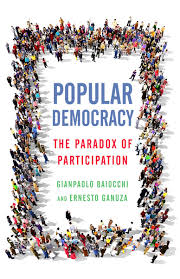Book review | Popular Democracy: The Paradox of Participation, by Gianpaolo Baiocchi & Ernesto Ganuza
In Popular Democracy: The Paradox of Participation, Gianpaolo Baiocchi and Ernesto Ganuza examine contemporary forms of participatory governance by tracing the origins and development of participatory budgeting (PB) from its roots in Porto Alegre, Brazil, to its adoption in two cases, Cordoba, Spain and Chicago, USA. While acknowledging that PB has been seen as being too easily co-opted by neoliberalism, the book’s critical yet hopeful perspective nonetheless illuminates the democratic potential of participatory instruments, writes Adrian Bua.

A woman speaks at a participatory budgeting meeting in Porto Alegre, Brazil, in March 2017. Photo: Joel Vargas/PMPA/ Prefeitura de Porto Alegre via a CC-BY-NC-SA 2.0 licence
For a debate with Gianpaolo Baiocchi and Ernesto Ganuza on the argument developed in Popular Democracy, visit the Book Debates section of the Centre for Urban Research on Austerity’s blog.
Popular Democracy: The Paradox of Participation. Gianpaolo Baiocchi and Ernesto Ganuza. Stanford University Press. 2016.
 Popular Democracy: The Paradox of Participation, written by Gianpaolo Baiocchi and Ernesto Ganuza, analyses contemporary forms of participatory governance by tracing the genesis and expansion of the now-famous mechanism of participatory budgeting (PB). Originating in the Southern Brazilian city of Porto Alegre and from the alliance between social movements and leftist political parties that rejected vanguardist strategy, the PB process sought to challenge the influence of clientelist networks over resource allocation, and to realise redistributive justice by devolving decisions over the city budget to a process of direct citizen participation.
Popular Democracy: The Paradox of Participation, written by Gianpaolo Baiocchi and Ernesto Ganuza, analyses contemporary forms of participatory governance by tracing the genesis and expansion of the now-famous mechanism of participatory budgeting (PB). Originating in the Southern Brazilian city of Porto Alegre and from the alliance between social movements and leftist political parties that rejected vanguardist strategy, the PB process sought to challenge the influence of clientelist networks over resource allocation, and to realise redistributive justice by devolving decisions over the city budget to a process of direct citizen participation.
Tracing its globalisation from Porto Alegre to the USA and to Europe (the ‘return of the caravels’, as one scholar puts it), Baiocchi and Ganuza cast a hopeful yet critical eye over the potentialities of this democratic institution. Both authors are academic researchers that have had a deep practical involvement in the two main case studies of the book: namely, participatory budgeting in Chicago, USA, and in Cordoba, Spain. Their experience adds depth to their political ethnographies and produces insights into the development of PB that are contextualised with historical analysis of the emergence of PB in Porto Alegre, its globalisation as well as broader developments in the interface of the theory and practice of democracy and public administration.
The central question that the book aims to answer – alluded to in its subtitle as the ‘paradox of participation’ – stems from the fact that these new institutions open up possibilities for democratic participation at a time when the space for democracy is being constrained by encroaching technocracy and the perceived need to appease markets. What opportunities do democratic innovations offer in the context of this paradox? Do they broaden possibilities to advance democracy and social justice, or do they narrow them by foreclosing alternative, more agonistic, forms of action that can challenge neoliberalism? In answering these questions, the authors carve open a space between sanguine advocates who celebrate the mainstreaming of democratic innovation and sceptical critics who identify and condemn their co-option by and perpetuation of neoliberalism.
Popular Democracy explores these issues by telling a series of interrelated stories. First, the book offers an historical account of changes in democratic and public administration theory and practice. Second, it traces the genesis and worldwide dissemination of the Porto Alegre Participatory Budget. This produces insights that the authors then bring their empirical research to bear upon, drawing on ethnographic research in two cases of PB that represent the first attempts to institutionalise it within Europe (Cordoba, Spain) and the USA (Chicago).
The book shows how, in travelling the globe, PB became de-coupled from (a) an explicit focus on social justice through the administration of large budgets; and (b) a set of institutional reforms that were concomitant in Porto Alegre and which reduced other channels for influence that could circumvent the participatory process. The result was that upon the ‘return of the caravels’, what disembarked was a softer engagement tool – a complement for existing administrative systems that handled smaller budgets and lost a focus on social justice. The impressive success of Porto Alegre did not therefore accompany the globalisation of PB. Instead, PB became an ideologically malleable instrument, explaining its present popularity in World Bank reports as well as in World Social Forum ambitions for social justice and emancipation.
So far, the story told is one of co-option and transformation into a neoliberal governance technology. But the story does not stop there. Three points are made in the book that give reason for hope and support of participatory governance. They are here presented in order of the importance I interpret them to have for the argument developed in the book. First, the co-option story can be inverted. The neoliberalisation of participatory governance can be read as a success in introducing logics of political participation into institutions that are tightly focused on capitalist efficiency. This ‘success’ is, however, stinted by the fact that here participation becomes a component of ‘good governance’ conditions for capital accumulation – something that the authors accept.
Second, Popular Democracy shows that institutional design matters. One of the questions that arises from the analysis of the spread of PB is why was the success of Porto Alegre not achieved elsewhere? The answer is two-fold. The design of the process in Porto Alegre combined a ‘communicative dimension’, whereby citizens deliberate to set priorities and investment agendas, with a ‘sovereignty dimension’, where participants shared decision-making power with politicians and officials and used their ownership of the process to inscribe social justice criteria in deliberation and decision-making rules. In the transfer to Europe and the USA, it was mainly the communicative dimension that held, leaving PB a de-politicised, malleable instrument that left participants thinking about trivial issues.
Related to this, PB was also de-coupled from a series of concomitant institutional reforms characterised as ‘political centralisation with administrative decentralisation’ (60-61). Administrative decentralisation through PB made the city administration more porous to citizen demands, and this was coupled with ‘political centralisation’ – a foreclosing of other channels for political influence. This combination of centralised planning and decentralised information gathering made PB the privileged, and perhaps only, channel for influencing the city budget, making it harder for city officials to deflect demands through other channels and for other organised interests to circumvent the PB process.
Ganuza and Baiocchi argue that the main reason for this was that PB travelled a path of least resistance, adopting designs and handling budget scopes that did not present danger to powerful interests. They also argue that rather than a story of neoliberal co-option, this is one of institutional de-linking. The authors accept that this indeed entailed important limits to the democratisation capacity of the process. However, as the ethnographic research in Cordoba and Chicago shows, it kept open spaces for new political subjects to come together – which brings us to the third, most substantive, point of the book.
In the three discrete cases that the authors analyse of the institutionalisation of PB, a common story of political contestation between established and new political subjects is told. All three generated tension between the individual citizens that PB prioritises and social movements supportive of PB on the one hand, and of city technocrats and established associations (‘privileged interlocutors’) on the other. The latter resisted PB by making claims to legitimate authority based on expertise and knowledge of the ‘common good’ versus the political actors that PB sought to bring centre stage, who were seen as inexperienced and self-interested. Established interests also worried that PB would raise civic expectations beyond the limits of what can be delivered within the political authority of the city.
At first sight, these tensions highlight problems in the institutionalisation of PB processes and can be seen as important limits to its potential. Indeed, they led to conflict over the rules and institutional design of the process, the outcomes of which were instrumental in the success of Porto Alegre and relative failure in Cordoba and Chicago. However, the authors argue that they were also generative of new democratic subjects who widened the scope of possibilities by making new demands. As the authors explain in the conclusion:
participants often interacted as if they ran city government, as if they really had power over technical rules, as if they really could control (and not just discuss) the outcomes of decisions that impacted them.
Baiocchi and Ganuza’s wager is that this experience is valuable in itself, because it enables collectivities to form that can imagine new futures and develop new forms of self-regulation and democratic organisation.
Thus, in conclusion, Baiocchi and Ganuza have considerable sympathy for the critical view that institutional innovations are easily co-opted into neoliberal governance instruments. But they argue that this perspective needs qualifying. Innovations also have value because they provide spaces for interactions that open new possibilities by raising questions that they cannot answer within their own parameters. The prominence and influence of PB on the political agendas and imaginaries advanced by social movements such as the ‘indignados’ or the ‘Next Systems Project’, where participatory instruments are afforded massive regulatory powers, are cited as evidence of this (160). The question and challenge that the book leaves for activists, practitioners and engaged scholars is how to make the most of the critical energies they summon.
This post represents the views of the authors and not those of Democratic Audit. It first appeared at the LSE Review of Books.
Adrian Bua is a researcher at the Centre for Urban Research on Austerity and at the New Economics Foundation.





 Democratic Audit's core funding is provided by the Joseph Rowntree Charitable Trust. Additional funding is provided by the London School of Economics.
Democratic Audit's core funding is provided by the Joseph Rowntree Charitable Trust. Additional funding is provided by the London School of Economics.